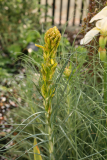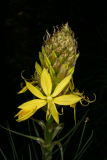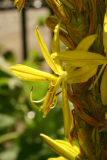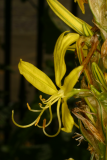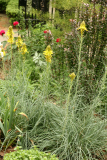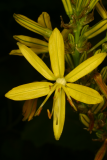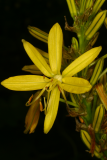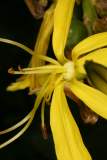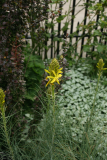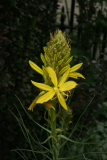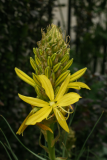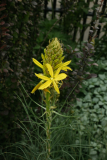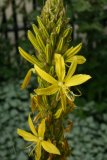Additional notes (click to expand)
Other use
Asphodeline lutea Rchb. Yellow asphodel, King's spear, Hastula regia. Hardy rhizomatous perennial. Distribution Mediterranean and Caucasus. It is the flower of the dead, as Homer writes that it carpets an area in the gloomy darkness of the underworld (Hades), in Greek mythology where the souls of the dead are found. However this may be a misinterpretation of the Greek where 'Asphodel' has been read instead of 'ash-filled'. In the etymology of flower names, it is suggested that the yellow 'daffodil' is a a corruption of French or Flemish 'de asphodel' (both ex Steve Reece, 2007). An Aristotelian epigram, refers to it growing on tombs: 'On my back I hold mallow and many-rooted asphodel ...' The asphodel was sacred to Persephone, goddess of the underworld, who was seized and wed by Hades, god of the underworld, and taken to his kingdom. Her disappearance brings the winter, and her reappearance each year, the spring. The only reliable source of information about its early medical uses is, probably, Dioscorides although the plant in his De Materia Medica may be A. ramosus or A. albus. He gives its properties as diuretic, induces menses, good for coughs and convulsions, an antidote to snake bite, applied as a poultice for sores of all sorts, and in compounds for eye, ear and tooth pains, and to cure alopecia and vitiligo, but induces diarrhoea and vomiting and is an anti-aphrodisiac. Fuchs (1542), as Ruel’s commentaries (1543) note, makes a big mistake as he has Lilium martagon as his concept of A. luteus. Ruel, only illustrates its leaves and roots, calling it Hastula regia (Latin for King’s spear) but Mathiollus has a reasonable woodcut, also as Hastula regia (1569). Dodoen's Cruydeboeck (1556) does not mention or illustrate Asphodelus luteus. L'Escluse's French translation Histoire des Plantes (1557) follows the Cruydeboeck. Dodoen's Latin translation Stirpium Historia Pemptades Sex adds A. luteus with text and woodcut, with no uses. Henry Lyte's (1578) translation illustrates Asphodelus luteus as Asphodeli tertia species and 'Yellow affodyl' (vide etymology of 'daffodil') and also does not describe any uses for it. Gerard's translation The Herbal (1587 and 1633) continues the muddle and does not give any uses for this plant. Parkinson's comments (1640) on the lack of medicinal properties of asphodels, refer to plants coming from wet areas in Lancashire, Scotland and Norway . He calls them pseudoasphodelus major and minor which he writes are called Asphodelus luteus palustris by Dodoens , and not 'King's Spear' which he illustrates with a good woodcut of A. luteus and calls it Asphodelus luteus minor. Once herbals started to be written in northern Europe, the knowledge of the arid loving, Asphodelus luteus of south east Europe was lost.
Oakeley, Dr. Henry F. (2013). Wellcome Library notes.
link
Geographical distribution
- Africa, Northern Africa, Algeria
- Africa, Northern Africa, Tunisia
- Asia-Temperate, Caucasus, Transcaucasus
- Asia-Temperate, Western Asia, Cyprus
- Asia-Temperate, Western Asia, Israel
- Asia-Temperate, Western Asia, Jordan
- Asia-Temperate, Western Asia, Lebanon-Syria
- Asia-Temperate, Western Asia, Turkey
- Europe, Eastern Europe, Ukraine
- Europe, Southeastern Europe, Albania
- Europe, Southeastern Europe, Bulgaria
- Europe, Southeastern Europe, Greece
- Europe, Southeastern Europe, Italy
- Europe, Southeastern Europe, Romania
- Europe, Southeastern Europe, Yugoslavia
Asphodeline lutea (L.) Rchb.
Family: ASPHODELACEAEGenus: Asphodeline
Species: lutea (L.) Rchb.
Common names: Asphodel; Jacob's Rod
Distribution summary: Mediterranean to Caucasus
Habit: Perennial
Hardiness: H5 - Hardy; cold winter
Habitat: Short grassland
Garden status: Currently grown
Garden location: Europe & Middle East (J)
Flowering months: June, July
Reason for growing: Other use
